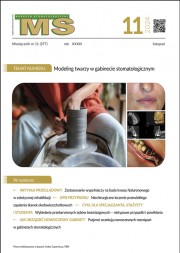Dostęp do tego artykułu jest płatny.
Zapraszamy do zakupu!
Po dokonaniu zakupu artykuł w postaci pliku PDF prześlemy bezpośrednio pod twój adres e-mail.
Ultrasonics – an effective method of activating solutions for irrigation of root canals
Hubert Gołąbek, Katarzyna Brus-Sawczuk
Zakład Stomatologii Zintegrowanej Warszawskiego Uniwersytetu Medycznego
Streszczenie
Współczesny, bogaty rynek stomatologiczny w zakresie endodoncji daje lekarzowi możliwość wyboru spośród wielu systemów przeznaczonych nie tylko do opracowania kanałów korzeniowych, ale również do wspomagania dezynfekcji w postaci aktywacji roztworów irygacyjnych. Techniki dźwiękowe, ultradźwiękowe, mechaniczne, a w ostatnim czasie również laserowe stanowią dodatkowe narzędzie do zwiększenia efektywności dezynfekcji oraz oczyszczenia systemu kanałowego przed ostatecznym wypełnieniem. Roztworem najczęściej wykorzystywanym i tym samym aktywowanym jest podchloryn sodu o silnych właściwościach proteolitycznych, antybakteryjnych (przeciw bakteriom Gram+ oraz Gram-) oraz przeciwgrzybiczych. Najbardziej rozpowszechnioną techniką aktywacji roztworów płuczących jest metoda ultradźwiękowa.
Abstract
The contemporary dental market, plentiful in endodontic products gives the dentist the possibility of choice from among many systems designed not only to instrumenting root canals, but also to help disinfection in the form of activating solutions for irrigation. Sound, ultrasound, mechanical and also in recent times, laser techniques, provide additional tools for effective disinfection and cleaning of the canal system before final filling. The most commonly used and at the same time activated is sodium hypochlorite with strong proteolytic, antibacterial properties (against Gram+ and Gram- bacteria) and antifungal. The most widespread technique to activate irrigation solutions is the ultrasonic method.
Hasła indeksowe: ultradźwięki, irygacja, leczenie kanałowe
Key words: ultrasound, irrigation, root canal treatment
Piśmiennictwo
1. Boutsioukis Ch. i wsp.: Evaluation of irrigant flow in the root canal using different needle types by an unsteady computational fluid dynamics model. J. Endod., 2010, 36, 875 879.
2. Boutsioukis Ch. i wsp.: The effect of needle – insertion depth on the irrigant flow in the root canal: evaluation using an unsteady computational fluid dynamics model. J. Endod., 2010, 36, 1664 1668.
3. Metzger Z. i wsp.: The self¬ adjusting file (SAF). Part 1: respecting the root canal anatomy – a new concept of endodontic files and its implementation. J. Endod., 2010, 36, 679 690.
4. Arslan M. i wsp.: An in vitro comparison of irrigation using photon¬ initiated photoacoustic streaming, ultrasonic, sonic and needle techniques in removing calcium hydroxide. Int. Endod. J., 2015, 48, 246 251.
5. Gołąbek H. i wsp.: Review of techniques and current possibilities of root canal irrigation. Den-tal Forum, 2015, XLIII, 85 92.
6. Macedo R. i wsp.: Cavitation measurement during sonic and ultrasonic activated irrigation, J. Endod., 2014, 40, 4, 58 583.
7. Baker N.A., Eleazer P.D., Averbach R.E.: Scanning electron microscopic study of the efficacy of various irrigation solutions. J. Endod., 1975, 1, 127 135.
8. Beer R.: Ilustrowane Kompendium Endodoncji. Wyd. Czelej 2009, 156 157.
9. Błochowiak K., Witmanowski H.: Pozytywne i negatywne aspekty stosowania ultradźwięków w stomatologii – na podstawie piśmiennictwa. Czas. Stomatol., 2005, LVIII, 3, 201 206.
10. Sabins R.A., Johnson J.D., Hellstein J.W.: A comparison of the cleaning efficacy of short¬ term sonic and ultrasonic passive irrigation after hand instrumentation in molar root canals. J. Endod., 2003, 29, 674 678.
11. Paqué F., Boessler C., Zehnder M.: Accumulated hard tissue debris levels in mesial roots of mandibular molars after sequential irrigation steps. Int. Endod. J., 2011, 44, 2, 148 153.
12. Al¬ Jadaa A. i wsp.: Acoustic hypochlorite activation in simulated curved canals. J. Endod., 2009, 35, 10, 1408 1411.
13. de Gregorio C. i wsp.: Efficacy of different irrigation and activation systems on the penetra-tion of sodium hypochlorite into simulated lateral canals and up to working length: an in vitro stu-dy. J. Endod., 2010, 36, 7, 1216 1221.
14. de Gregorio C. i wsp.: Efficacy of irrigation systems on penetration of sodium hypochlorite to working length and to simulated uninstrumented areas in oval shaped root canals. Int. Endod. J., 2012, 45, 5, 475 481.
15. de Gregorio C. i wsp.: Effect of EDTA, sonic, and ultrasonic activation on the penetration of sodium hypochlorite into simulated lateral canals: an in vitro study. J. Endod., 2009, 5, 6, 891 895.













